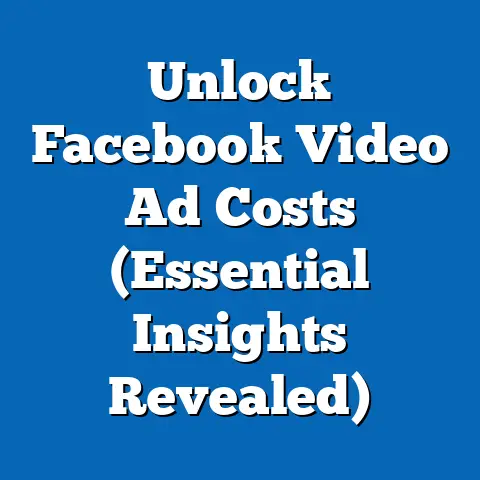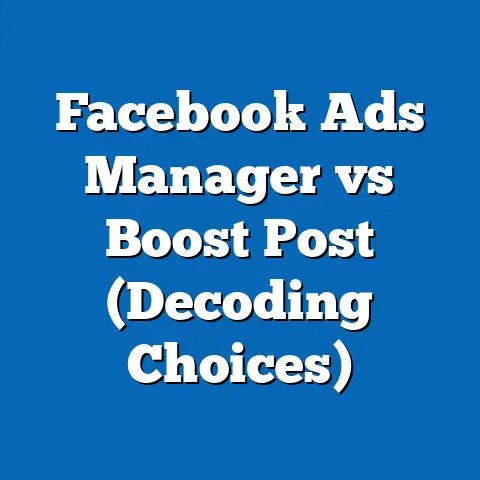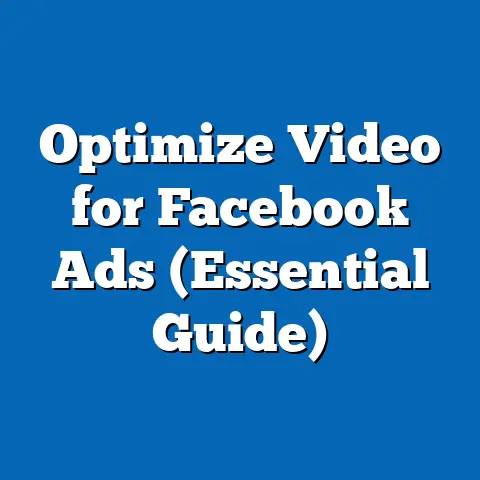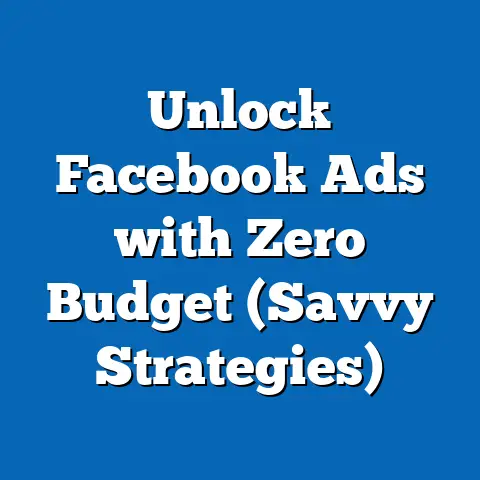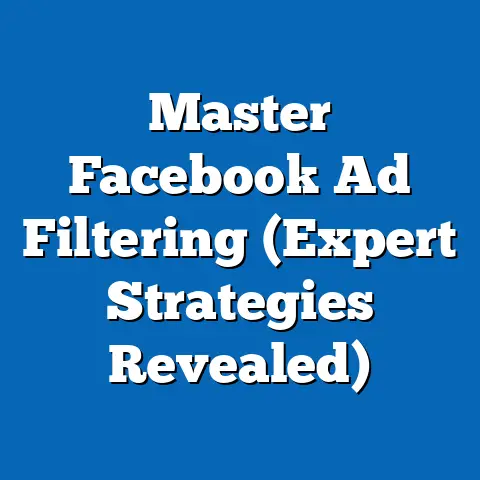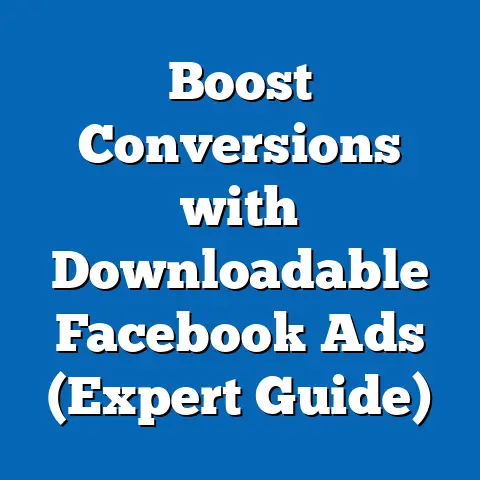Master Facebook Learning Ads (Expert Strategies Revealed)
In the dynamic world of digital marketing, staying ahead of the curve is crucial. Facebook, with its massive user base and sophisticated advertising platform, offers a powerful avenue for businesses to reach their target audience. But let’s face it, traditional Facebook ads can sometimes feel like throwing darts in the dark. That’s where Facebook Learning Ads come in. They’ve become the secret weapon for brands looking to skyrocket their conversion rates and optimize their ad spend like never before.
I remember when I first started running Facebook ads, it was a lot of guesswork. I’d spend hours tweaking targeting options and creative, hoping something would stick. It was time-consuming and, frankly, frustrating. Then I discovered Learning Ads, and it was a game-changer.
This article isn’t just another guide; it’s your roadmap to mastering Facebook Learning Ads. I’ll walk you through everything from understanding the fundamentals to implementing expert strategies that can transform your Facebook advertising campaigns. You’ll learn how to leverage machine learning to its fullest potential, optimize your ad spend, and achieve measurable results. So, buckle up, and let’s dive in!
Understanding Facebook Learning Ads
What are Facebook Learning Ads?
Facebook Learning Ads are a specialized type of campaign that leverages Facebook’s powerful machine learning algorithms to optimize ad delivery and performance. Unlike traditional campaigns where you manually adjust targeting, bidding, and creative, Learning Ads automate much of this process. The goal is to allow Facebook’s system to learn from user interactions and continuously improve the results you achieve.
Think of it as having a team of data scientists working tirelessly behind the scenes, analyzing every click, impression, and conversion to fine-tune your ads for maximum impact.
The core concept revolves around the “learning phase.” During this initial period, the algorithm experiments with different ad combinations, audience segments, and delivery strategies to identify what works best. Once the learning phase is complete, your campaign enters a stable state, delivering consistent results with minimal manual intervention.
How Do Learning Ads Differ From Traditional Facebook Ads?
The key difference lies in the level of automation and machine learning involved. In traditional campaigns, you’re responsible for making most of the decisions, from setting bids to selecting audience targets. With Learning Ads, you provide the system with a broader set of parameters and allow it to optimize within those boundaries.
Here’s a breakdown of the key differences:
- Automation: Learning Ads automate many aspects of campaign management, including bidding, targeting, and creative optimization. Traditional ads require more manual intervention.
- Machine Learning: Learning Ads use machine learning algorithms to analyze user data and improve ad performance over time. Traditional ads rely more on your own intuition and analysis.
- Learning Phase: Learning Ads go through a learning phase where the algorithm experiments with different strategies. Traditional ads don’t have this built-in learning period.
- Dynamic Creative: Learning Ads often utilize dynamic creative, which allows Facebook to automatically generate different ad variations based on user preferences. Traditional ads typically use static creative.
The Mechanics: How Machine Learning Powers Optimization
The magic of Learning Ads lies in the power of machine learning. Facebook’s algorithms analyze vast amounts of user data, including demographics, interests, behaviors, and purchase history, to identify patterns and predict which ads are most likely to resonate with specific individuals.
Here’s a simplified overview of the process:
- Data Collection: Facebook collects data on user interactions with your ads, including clicks, impressions, conversions, and engagement metrics.
- Pattern Recognition: The machine learning algorithms analyze this data to identify patterns and correlations between user characteristics and ad performance.
- Prediction: Based on the patterns identified, the algorithm predicts which users are most likely to convert or take the desired action.
- Optimization: The algorithm adjusts ad delivery, bidding, and creative to target the most promising users and maximize results.
- Continuous Learning: The process is iterative, with the algorithm continuously learning and improving its predictions over time.
Advantages of Using Learning Ads
The benefits of using Learning Ads are numerous and can significantly impact your advertising results:
- Improved Performance: By leveraging machine learning, Learning Ads can often achieve higher conversion rates, lower costs per acquisition, and better overall ROI compared to traditional campaigns.
- Time Savings: The automation features of Learning Ads free up your time to focus on other aspects of your marketing strategy, such as creative development and audience research.
- Data-Driven Decisions: Learning Ads provide valuable insights into your target audience and what resonates with them, allowing you to make more informed decisions about your marketing efforts.
- Personalization: Dynamic creative and audience targeting options enable you to deliver personalized ad experiences that are more likely to capture attention and drive engagement.
- Scalability: Once your Learning Ads campaign is optimized, it can be easily scaled to reach a wider audience and generate even more results.
Key Takeaway: Facebook Learning Ads harness the power of machine learning to optimize your ad campaigns, leading to improved performance, time savings, and data-driven decisions. This makes them a powerful tool for any business looking to maximize their advertising ROI on Facebook.
Setting Up Your Facebook Learning Ads Campaign
Now that you understand the fundamentals of Learning Ads, let’s get practical. Setting up a successful campaign requires careful planning and execution. I’ll walk you through the essential steps to ensure your campaign is set up for success.
Choosing the Right Campaign Objective
The first step is to define your campaign objective. What do you want to achieve with your Learning Ads? Facebook offers a variety of campaign objectives, each designed to optimize for a specific outcome.
Here are some common objectives and their use cases:
- Conversions: This objective is ideal for driving sales, leads, or other desired actions on your website or app. Facebook will optimize your ads to target users who are most likely to convert.
- Traffic: If your goal is to drive traffic to your website or blog, this objective is a good choice. Facebook will optimize your ads to target users who are most likely to click on your ad and visit your site.
- Engagement: This objective is suitable for increasing brand awareness, generating likes, shares, and comments on your posts, or driving attendance to events.
- Lead Generation: Use this objective to collect leads directly on Facebook through lead forms. This is a great option for businesses that want to generate leads without sending users to their website.
- App Installs: If you want to promote your mobile app, this objective is designed to drive app installs.
When choosing your campaign objective, consider your overall marketing goals and the specific actions you want users to take. A clear objective will help Facebook’s algorithm optimize your ads effectively.
Setting Up the Facebook Pixel for Accurate Tracking
Here’s how to set up the Facebook Pixel:
- Create a Pixel: In the Facebook Ads Manager, go to “Events Manager” and click “Connect Data Sources.” Select “Web” and follow the instructions to create a new pixel.
- Install the Pixel Code: Copy the pixel code and paste it into the
<head>section of every page on your website. - Set Up Standard Events: Standard events are predefined actions that you can track, such as “Purchase,” “Add to Cart,” “Lead,” and “Complete Registration.” Implement these events on the relevant pages of your website.
- Custom Conversions (Optional): If you want to track specific actions that aren’t covered by standard events, you can create custom conversions. For example, you might create a custom conversion to track users who visit a specific page on your website.
Ensure your pixel is installed correctly and tracking events accurately. This data is crucial for optimizing your Learning Ads campaigns and measuring your ROI.
Designing Ad Creatives That Resonate
Your ad creative is what captures the attention of your target audience and persuades them to take action. It’s essential to create ad creatives that are visually appealing, relevant, and engaging.
Here are some tips for designing effective ad creatives:
- Use High-Quality Images and Videos: Your visuals should be professional-looking and relevant to your product or service.
- Write Compelling Ad Copy: Your ad copy should be clear, concise, and persuasive. Highlight the benefits of your product or service and include a strong call to action.
- Test Different Ad Formats: Facebook offers a variety of ad formats, including image ads, video ads, carousel ads, and collection ads. Experiment with different formats to see what works best for your target audience.
- Use Dynamic Creative: Dynamic creative allows Facebook to automatically generate different ad variations based on user preferences. This can help you personalize your ads and improve performance.
Defining Your Target Audience
Defining your target audience is crucial for ensuring your ads are seen by the right people. Facebook offers a variety of audience targeting options, allowing you to reach users based on demographics, interests, behaviors, and more.
Here are some key targeting options to consider:
- Demographics: Target users based on age, gender, location, education, and other demographic factors.
- Interests: Target users based on their interests, hobbies, and activities.
- Behaviors: Target users based on their online behavior, such as purchase history, website visits, and app usage.
- Custom Audiences: Create custom audiences based on your existing customer data, such as email lists or website visitors.
- Lookalike Audiences: Expand your reach by targeting users who are similar to your existing customers.
When defining your target audience, be specific and avoid targeting too broad of an audience. The more targeted your audience, the more effective your ads will be.
Key Takeaway: Setting up your Facebook Learning Ads campaign involves choosing the right objective, setting up the Facebook Pixel, designing compelling ad creatives, and defining your target audience. These steps are crucial for ensuring your campaign is set up for success and can achieve your desired results.
Expert Strategies for Optimizing Learning Ads Performance
Once your Learning Ads campaign is set up, the real work begins. Optimizing your campaign for maximum performance requires a combination of data analysis, creative experimentation, and strategic adjustments. I’ll share some expert strategies that can help you take your Learning Ads to the next level.
Using A/B Testing to Refine Ad Creatives and Messaging
A/B testing, also known as split testing, is a powerful technique for comparing different versions of your ads to see which performs best. By testing different ad creatives, headlines, body copy, and calls to action, you can identify the elements that resonate most with your target audience.
Here’s how to conduct effective A/B tests:
- Identify Variables to Test: Choose one element of your ad to test at a time, such as the headline, image, or call to action.
- Create Variations: Create two or more variations of your ad with different versions of the element you’re testing.
- Run Your Test: Run your ads with the different variations and track their performance.
- Analyze Results: After a sufficient amount of time, analyze the results to see which variation performed best.
- Implement Winning Variation: Implement the winning variation in your campaign and continue testing other elements.
A/B testing is an ongoing process, so don’t be afraid to experiment and try new things. The more you test, the more you’ll learn about what works best for your target audience.
Implementing Dynamic Ads for Enhanced Personalization
Dynamic ads are a powerful way to personalize your ad experiences and improve performance. Dynamic ads automatically generate different ad variations based on user preferences, such as their browsing history, purchase history, or interests.
Here’s how to implement dynamic ads:
- Create a Product Catalog: Upload your product catalog to Facebook, including information such as product names, descriptions, images, and prices.
- Set Up Dynamic Ad Templates: Create ad templates that will be used to generate dynamic ads. These templates should include placeholders for product information, such as the product name, image, and price.
- Target Your Audience: Target your audience based on their browsing history or purchase history. For example, you might target users who have viewed a specific product on your website.
- Let Facebook Do the Work: Facebook will automatically generate dynamic ads based on the product catalog and user preferences.
Dynamic ads are particularly effective for e-commerce businesses, as they allow you to show users ads for products they’re actually interested in.
Leveraging Lookalike Audiences to Expand Reach
Lookalike audiences are a powerful way to expand your reach and target new users who are similar to your existing customers. Facebook uses your existing customer data, such as email lists or website visitors, to identify users who share similar characteristics.
Here’s how to create lookalike audiences:
- Create a Source Audience: Create a source audience based on your existing customer data. This can be an email list, website visitors, or app users.
- Create a Lookalike Audience: In the Facebook Ads Manager, create a lookalike audience based on your source audience.
- Choose Your Audience Size: Choose the size of your lookalike audience. A smaller audience will be more similar to your source audience, while a larger audience will have a broader reach.
- Target Your Lookalike Audience: Target your lookalike audience with your ads.
Lookalike audiences are a great way to reach new customers who are likely to be interested in your products or services.
Best Practices for Budget Allocation and Bidding Strategies
Budget allocation and bidding strategies play a crucial role in the success of your Learning Ads campaigns. It’s essential to allocate your budget effectively and choose the right bidding strategy to maximize your ROI.
Here are some best practices for budget allocation and bidding strategies:
- Start with a Test Budget: Before launching a full-scale campaign, start with a test budget to experiment with different targeting options, ad creatives, and bidding strategies.
- Allocate Budget Based on Performance: Allocate more budget to the campaigns and ad sets that are performing best.
- Use Automatic Bidding: Automatic bidding allows Facebook to automatically set your bids based on your campaign objective and budget. This is a good option for beginners, as it simplifies the bidding process.
- Consider Manual Bidding: Manual bidding allows you to set your bids manually. This gives you more control over your bidding strategy, but it also requires more expertise.
- Monitor Your Costs: Monitor your costs closely and adjust your budget and bidding strategies as needed.
Key Takeaway: Optimizing your Learning Ads performance requires a combination of A/B testing, dynamic ads, lookalike audiences, and effective budget allocation and bidding strategies. By implementing these expert strategies, you can significantly improve your campaign results and achieve your marketing goals.
Analyzing and Interpreting Learning Ads Data
Running a successful Facebook Learning Ads campaign isn’t just about setting it up and letting it run. It’s about constantly monitoring, analyzing, and interpreting the data to make informed decisions and optimize your performance. I’ll guide you through the key performance indicators (KPIs) to watch and how to use the Facebook Ads Manager to extract valuable insights.
Key Performance Indicators (KPIs) to Monitor
KPIs are the metrics that indicate how well your campaign is performing. Monitoring these KPIs will help you identify areas for improvement and make data-driven decisions.
Here are some essential KPIs to track:
- Reach: The number of unique people who saw your ad. This indicates how wide your audience is.
- Impressions: The number of times your ad was displayed. This indicates how frequently your ad is being shown.
- Click-Through Rate (CTR): The percentage of people who clicked on your ad after seeing it. This indicates how engaging your ad creative and messaging are.
- Conversion Rate: The percentage of people who completed a desired action, such as making a purchase or filling out a form, after clicking on your ad. This indicates how effective your ad is at driving conversions.
- Cost Per Click (CPC): The average cost you pay for each click on your ad. This indicates how efficient your bidding strategy is.
- Cost Per Acquisition (CPA): The average cost you pay for each conversion. This indicates how cost-effective your campaign is at achieving your desired outcome.
- Return on Ad Spend (ROAS): The amount of revenue you generate for every dollar you spend on ads. This indicates the overall profitability of your campaign.
Analyzing Ad Performance Data in Facebook Ads Manager
The Facebook Ads Manager is your command center for analyzing ad performance data. It provides a wealth of information about your campaigns, ad sets, and ads, allowing you to identify trends, patterns, and areas for improvement.
Here’s how to analyze ad performance data in the Facebook Ads Manager:
- Navigate to the Ads Manager: Go to the Facebook Ads Manager and select the campaign, ad set, or ad you want to analyze.
- Customize Columns: Customize the columns to display the KPIs you want to monitor.
- Filter and Segment Data: Filter and segment your data to identify trends and patterns. For example, you can filter by age, gender, location, or placement.
- Compare Time Periods: Compare performance data from different time periods to see how your campaign is trending.
- Analyze Ad Creative Performance: Analyze the performance of different ad creatives to see which ones are resonating most with your target audience.
Making Data-Driven Decisions Based on Ad Performance
The ultimate goal of analyzing ad performance data is to make data-driven decisions that improve your campaign results. By understanding what’s working and what’s not, you can adjust your targeting, ad creative, and bidding strategies to optimize your performance.
Here are some examples of data-driven decisions you can make:
- If your CTR is low: Test different ad creatives and headlines to see if you can improve engagement.
- If your conversion rate is low: Review your landing page and ensure it’s optimized for conversions.
- If your CPA is high: Adjust your targeting or bidding strategy to reduce your costs.
- If your ROAS is low: Re-evaluate your campaign objective and ensure you’re targeting the right audience.
Key Takeaway: Analyzing and interpreting Learning Ads data is crucial for optimizing your campaign performance. By monitoring key performance indicators and using the Facebook Ads Manager to extract valuable insights, you can make data-driven decisions that improve your results and achieve your marketing goals.
Troubleshooting Common Issues with Learning Ads
Even with the best planning and optimization, you might encounter challenges when running Facebook Learning Ads. The algorithms, while powerful, aren’t perfect, and external factors can also impact performance. I’ll address some common issues and provide practical troubleshooting tips to get your campaigns back on track.
Common Challenges Advertisers Face
Here are some of the most common challenges advertisers face when using Learning Ads:
- Low Engagement: Your ads aren’t getting enough clicks, likes, shares, or comments.
- High Costs: Your costs per click or cost per acquisition are too high.
- Ad Fatigue: Your ads are losing their effectiveness over time.
- Limited Reach: Your ads aren’t reaching enough people.
- Poor Conversion Rate: Your ads aren’t driving enough conversions.
- Learning Phase Stuck: Your ads are stuck in the learning phase and not optimizing properly.
Solutions and Troubleshooting Tips
Here are some solutions and troubleshooting tips for addressing these common issues:
Adjusting Targeting Parameters
If you’re experiencing low engagement, high costs, or limited reach, your targeting parameters may be too narrow or too broad.
- Expand Your Audience: Try expanding your audience by targeting a broader range of interests, behaviors, or demographics.
- Refine Your Audience: If your audience is too broad, try refining it by adding more specific targeting criteria.
- Test Different Audiences: Experiment with different audiences to see which ones perform best.
- Use Lookalike Audiences: Leverage lookalike audiences to reach new users who are similar to your existing customers.
Refreshing Ad Creative to Combat Ad Fatigue
Ad fatigue occurs when your ads become less effective over time because users have seen them too many times.
- Rotate Ad Creatives: Regularly rotate your ad creatives to keep your ads fresh and engaging.
- Test New Ad Formats: Experiment with different ad formats, such as image ads, video ads, carousel ads, and collection ads.
- Update Your Ad Copy: Refresh your ad copy to highlight different benefits or features of your product or service.
- Use Dynamic Creative: Dynamic creative allows Facebook to automatically generate different ad variations, which can help combat ad fatigue.
Modifying Budget and Bidding Strategies for Better Performance
If you’re experiencing high costs or poor conversion rates, your budget and bidding strategies may need to be adjusted.
- Increase Your Budget: Increasing your budget can allow Facebook to reach a wider audience and generate more conversions.
- Lower Your Bids: Lowering your bids can reduce your costs, but it may also reduce your reach.
- Switch to Automatic Bidding: Automatic bidding allows Facebook to automatically set your bids based on your campaign objective and budget.
- Use Value-Based Bidding: Value-based bidding allows you to optimize your bids based on the value of each conversion.
Getting Out of the Learning Phase
If your ads are stuck in the learning phase, it means Facebook hasn’t collected enough data to optimize your campaign effectively.
- Increase Your Budget: Increasing your budget can allow Facebook to collect more data and exit the learning phase.
- Simplify Your Targeting: Simplifying your targeting can make it easier for Facebook to identify the best audience for your ads.
- Consolidate Ad Sets: Consolidating multiple ad sets into a single ad set can help Facebook collect more data and exit the learning phase.
- Avoid Making Significant Changes: Avoid making significant changes to your campaign during the learning phase, as this can reset the learning process.
Key Takeaway: Troubleshooting common issues with Learning Ads requires a combination of data analysis, creative experimentation, and strategic adjustments. By addressing these challenges and implementing the solutions outlined above, you can get your campaigns back on track and achieve your desired results.
Future Trends in Facebook Learning Ads
The world of digital advertising is constantly evolving, and Facebook Learning Ads are no exception. Staying informed about upcoming trends and changes is crucial for maintaining a competitive edge and maximizing your advertising ROI. Let’s explore some emerging trends and future directions for Facebook Learning Ads.
The Evolving Landscape of Facebook Advertising
Facebook advertising is becoming increasingly sophisticated, with new features and technologies being introduced regularly. Some key trends to watch include:
- AI-Powered Advertising: Artificial intelligence (AI) is playing an increasingly important role in Facebook advertising, with AI-powered tools being used for targeting, creative optimization, and bidding.
- Personalization: Personalization is becoming more important than ever, with users expecting ads to be relevant and tailored to their individual needs and interests.
- Video Advertising: Video advertising is continuing to grow in popularity, with video ads being more engaging and effective than static image ads.
- Interactive Content: Interactive content, such as quizzes, polls, and augmented reality experiences, is becoming more popular as a way to engage users and drive conversions.
- Privacy-Focused Advertising: With increasing concerns about data privacy, Facebook is introducing new features that allow users to control their ad preferences and limit data tracking.
Implications of Data Privacy Regulations
Data privacy regulations, such as the General Data Protection Regulation (GDPR) and the California Consumer Privacy Act (CCPA), are having a significant impact on Facebook advertising. These regulations require businesses to obtain user consent before collecting and using their data, which can make it more difficult to target ads effectively.
To adapt to these changes, advertisers need to:
- Obtain User Consent: Ensure you have obtained user consent before collecting and using their data for advertising purposes.
- Be Transparent: Be transparent about how you’re using user data and give users control over their ad preferences.
- Use First-Party Data: Focus on collecting and using first-party data, which is data you collect directly from your customers.
- Embrace Privacy-Enhancing Technologies: Explore privacy-enhancing technologies, such as differential privacy and homomorphic encryption, to protect user data while still being able to target ads effectively.
Emerging Technologies and Trends
Here are some emerging technologies and trends that are likely to shape the future of Facebook Learning Ads:
- Augmented Reality (AR): AR experiences are becoming more popular as a way to engage users and drive conversions.
- Virtual Reality (VR): VR experiences offer immersive and engaging ways to connect with customers.
- The Metaverse: The metaverse is a virtual world where users can interact with each other and with digital content. Facebook is investing heavily in the metaverse, and it’s likely to play an important role in the future of advertising.
- Blockchain Technology: Blockchain technology can be used to create more transparent and secure advertising ecosystems.
Key Takeaway: The future of Facebook Learning Ads is likely to be shaped by AI, personalization, video advertising, interactive content, data privacy regulations, and emerging technologies such as AR, VR, and blockchain. By staying informed about these trends and adapting your strategies accordingly, you can maintain a competitive edge and maximize your advertising ROI.
Conclusion
We’ve covered a lot of ground in this guide, from understanding the fundamentals of Facebook Learning Ads to implementing expert strategies for optimization and staying ahead of future trends. Hopefully, I’ve shown you that Learning Ads aren’t just a buzzword, but a powerful tool that can revolutionize your Facebook advertising efforts.
The key takeaways from this article are:
- Facebook Learning Ads leverage machine learning to optimize your ad campaigns, leading to improved performance, time savings, and data-driven decisions.
- Setting up your Facebook Learning Ads campaign involves choosing the right objective, setting up the Facebook Pixel, designing compelling ad creatives, and defining your target audience.
- Optimizing your Learning Ads performance requires a combination of A/B testing, dynamic ads, lookalike audiences, and effective budget allocation and bidding strategies.
- Analyzing and interpreting Learning Ads data is crucial for optimizing your campaign performance.
- Troubleshooting common issues with Learning Ads requires a combination of data analysis, creative experimentation, and strategic adjustments.
- The future of Facebook Learning Ads is likely to be shaped by AI, personalization, video advertising, interactive content, data privacy regulations, and emerging technologies.
Now, it’s time to put these strategies into action. Don’t be afraid to experiment, test new approaches, and learn from your results. The more you practice, the better you’ll become at mastering Facebook Learning Ads.
So, what are you waiting for? Dive deeper into Facebook Learning Ads, embrace the future of advertising, and unlock the full potential of your Facebook advertising campaigns. The results are waiting for you!

